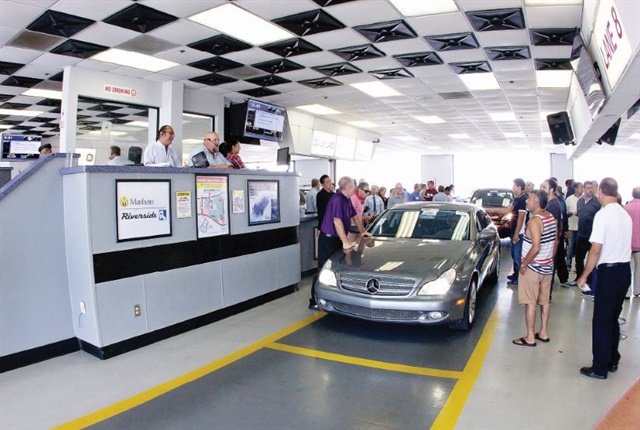Meeting the Challenge of Depreciation
The biggest expense category for fleets today continues to be depreciation.
Depreciation is the decline in value for a given vehicle asset over a set period of time. No matter the vehicle type — car, truck, van, or SUV — the asset will be depreciating, that is, losing value at varying rates based on a number of factors, including (but not limited to): age and mileage, vehicle type (e.g., van, sedan, SUV), model type, and acquisition costs.
“All of these factors influence the rate at which the vehicles diminish in value; the challenge for most fleets today is how best to manage the actual rate of deprecation to obtain the lowest net depreciation expense,” said Joe Korn, senior analyst for ARI.
There are concrete ways that fleet managers can control depreciation throughout the vehicle’s entire lifecycle.
Before the Sale
Minimizing depreciation should begin even before a vehicle joins the fleet. Fundamentally, there are two things that have to be taken into account prior to purchasing the vehicle.
“Before acquiring a vehicle, understand that minimizing capitalized cost and maximizing resale value are keys to minimizing the effective depreciation,” advised John Wuich, VP Strategic Consulting Services for Donlen. “That said, it is advisable to have both an acquisition policy that works to minimize the capitalized cost and a strong remarketing policy that works to maximize resale value. In addition, the overall fleet policy should cover maintaining and care/condition-reporting for the vehicle during its useful life. The goal is to replace vehicles at the point in time in which lifetime costs are at the lowest point.”
There are other factors fleets need to take into account, according to Sara Schingen, business Analyst for EMKAY.
“Companies need to determine forecasted residual values, the funds available for investing in the fleet, and whether a Closed End or TRAC lease works best for the fleet,” she said. “Lifecycle Cost Analyses are also an important step in determining the vehicle/depreciation combination. Maintenance and fuel costs should be considered if payment will be fixed.”
Since choosing a vehicle type (particularly if the fleet is aiming to buy hundreds of vehicles) is likely a long-term commitment of resources, fleet managers must look ahead when calculating vehicle depreciation.
“A proven optimum pre-purchase depreciation strategy is to select the lowest depreciating vehicle that will perform the required vehicle functions,” said Becky Langmandel, director of strategic modeling and analytics for LeasePlan USA. “Initial transaction price and auction sales price are equally important when it comes to minimizing depreciation expense. Therefore, the selected vehicle should have the smallest variance between capitalized cost and future secondary market net sales proceeds. By leveraging historical resale value data on a model/trim level, a fleet can identify which vehicles carry steeper depreciation than others. And, in conjunction with transaction price knowledge, the fleet manager can then perform reasonably accurate depreciation estimate comparisons.”
Research should be done using multiple sources, recommended Anil Goyal, senior vice president, operations for Black Book.
“Whenever you are doing projections, it is best practice to utilize residual projections from multiple sources so you can be more confident on your number,” he said. “Once you have the right data, rank order the vehicles in the vehicle segment for your need across different brands to understand vehicles with low to high depreciation.”
Keep in mind, the least expensive model isn’t always the best model in combatting depreciation.
“A vehicle with the most economical origination cost is not always the cheapest vehicle to operate over the lifecycle, and these factors along with OEM rebates, fuel, maintenance, and cost of capital should be evaluated as part of the selector offering process,” noted Brad Jacobs, director of strategic consulting for Merchants Fleet Management.
Trim levels need to be carefully analyzed.
“On selecting the trims, look for vehicles with higher retail demand comparing the wholesale values across the trims,” said Goyal.
A vehicle that may have a higher up-front cost may be the best option in the long run.
“At times there may be a cheaper options package on a vehicle, but it may depreciate at a higher than normal rate,” said Peter Grupposo, vice president of national accounts for Manheim. “In other cases, some technology packages carry high up-front costs, but do not translate to a similar value when the vehicle reaches its end of fleet service.”
Caution should be used when including upgrades.
“Be careful when considering upgrades,” noted Bob Sandler, SVP, strategic consulting for Element, “as they can negatively impact depreciation. Often, the incremental cost will add little to the expected resale value, resulting in higher depreciation costs. You could consider permitting driver-paid options that enhance resale if driver satisfaction is a concern.”
However, Sandler cautioned against using depreciation as the only component for making vehicle purchase decisions.
“In managing the TCO, a fleet manager should evaluate depreciation as a major component of the cost, but should not ignore other costs, including fuel, maintenance, taxes, etc. when selecting vehicles for their fleets,” he said.
It’s not just analysis that should be part of the process. Fleets can take active steps to manage depreciation on the front end.
“Some of the ways to bring down initial cost is with incentives that you negotiate through the manufacturer,” said Scott Edidin, senior account manager for Wheels Inc.
Sandler also advised that fleets should make most if not all of their orders factory orders.
“Purchasing vehicles from stock typically results in higher acquisition costs and unnecessary or undesirable equipment,” he said.
Doing lifecycle analysis based on usage is important as well.
“Determining the annual mileage and anticipated cycling parameters enables you to find the best fit for each driver,” said Schingen. “A simple way to do this is to leverage the historical effectiveness of depreciations on a per-driver basis. It’s also vital to pay attention to how each vehicle will be utilized and to spec them out accordingly.”
Timing the Purchase
Timing is a recurring motif in the quest to control depreciation.
“Time your purchases to coincide with the beginning of the model year,” said Sandler of Element. “Vehicles purchased at the beginning of the model-year typically depreciate less on a per monthly basis than vehicles purchased near the end of the model year. When considering a vehicle selector, make certain to incorporate start of production and order-to-delivery timelines to ensure vehicles selected can be provided to drivers during the timeframe expected.”
This emphasis on timing is a crucial part of the depreciation equation.
“From a model-year perspective, all other factors being equal, it is more economical to order and dispose in the early part of the model-year cycle, as depreciation is roughly half time and half usage,” said Paul Fortin, economist and vice president, strategic modeling and analytics for LeasePlan USA. “So the sooner you sell a vehicle within a given model year, the higher the proceeds will be.”
Even with all these steps taken into account, there’s one fundamental consideration that trumps all the others — is the vehicle being purchased the right one for the driver to do his or her job?
“This is important not only in light-duty truck fleets, but with sales fleets as more often than not, salespeople are required to carry product or other business needs that will limit their choice of vehicle,” said Korn of ARI. “Once the proper type of vehicle is chosen, research is necessary to choose the right balance of acquisition cost, vehicle popularity, and intended service life. Having a vehicle that has the best overall depreciation due to the popularity of a certain model or simply lower cost is irrelevant if the operator cannot function in it.”
Spec’ing the Vehicle
Choosing the right vehicle for the job is a crucial component of a fleet manager’s job, but care needs to be given when spec’ing a vehicle, particularly in the context of depreciation.
“Choosing options that best suit the needs of the business are the priority, but fleets need to exercise caution when choosing custom one-off type of upfit or specialty vehicle colors,” said Korn of ARI. “Although in some cases this cannot be avoided, these atypical modifications can negatively impact the ability to remarket the vehicle.”
It can become a fine-tuned balancing act to spec a vehicle in a way that serves the fleet, but also will appeal to the market as a whole.
“Specifications for powertrain configurations on work/medium-duty/heavy-duty trucks should be carefully developed so as to define the most efficient configuration for the intended use,” said Wuich of Donlen. “This applies to upfits as well. It may also benefit where possible to remove and repurpose the upfit items, particularly if the item is unique to the seller or not of value to a buyer.”
Fleets need to use particular care when determining whether to add a factory upgrade or third-party upfit.
“From a pure depreciation perspective, almost all factory-ordered options, upgrades, and third-party upfits depreciate at a faster rate than the underlying base vehicle,” said Fortin of LeasePlan USA. “Therefore, the more dollars spent above base invoice on these adds, the higher the depreciation expense will be, either on a cents per mile or dollars per month perspective.”
Again, this is where the balancing act comes in — the functionality of the vehicle and its depreciation.
In the Fleet
It is when a vehicle joins a fleet that depreciation begins in fact and earnest, but it is also the point when the fleet manager has the most control over depreciation.
The most important steps that a fleet manager can do to control depreciation are the most obvious and fundamental — but are crucial in the context of controlling depreciation.
“Making sure that scheduled maintenance is done is the single most important thing they can do,” said Grupposo of Manheim.
Maintenance both in terms of mechanical operations and aesthetics should be a key component of the fleet policy, according to Sandler of Element.
“Fleet policy should set expectations for condition and hold drivers accountable for excessive damage to the vehicle which could include unreported accident damage, he said.
Wuich of Donlen added that driver accountability should be among the top factors influencing how vehicles are maintained.
“Concerning appearance, drivers should be expected to keep the asset reasonably clean and promptly note items that need to be repaired or replaced,” he said. “Driver behaviors can also impact vehicle resale value. Excessive speeding, fast start, and harsh deceleration will work to reduce fuel economy and cause more rapid wear and tear. The same driver behaviors can increase the risk of vehicle accidents, and damage resulting from an accident will work to reduce remarketing interest and value.”
Keeping a vehicle well maintained inside and out — and that includes repairing interior stains, tears, eliminating smells, and fixing exterior dents, dings, and scratches — will reap benefits for the fleet and its company.
“Clean, well-maintained vehicles help promote higher resale values, which provides overall improved depreciation,” said Korn of ARI.
This is particularly the case if maintenance is well documented, observed Wuich of Donlen.
“A detailed maintenance history showing that schedules have been maintained will only work to increase resale value,” he said.
Again, driver use should be considered in the analysis as well, according to EMKAY’s Schingen.
“If you’re not depreciating the vehicle based off of a driver’s use it will only lead to further issues,” she said. “Next is to determine the break-even point. It’s important for the customer to determine whether they want higher returns or breakeven at sale. Equity is extremely important as it can be used to reinvest back to the fleet.
The process of controlling depreciation should be one component of vehicle total cost of ownership (TCO).
“As a best practice, fleet managers should look at fleet spend holistically — total cost of ownership is the most appropriate way to manage costs,” said Sandler of Element. “Depreciation, fuel, and maintenance typically make up the majority of spend, so much of the focus should be on these cost components. Ultimately, the decision should be to select the best vehicle for the job at the lowest overall total cost of ownership.”
Timing the Sale
As with purchasing a vehicle, disposing of it is also a matter of the right timing. Fleet managers should be flexible on this point, according to Sandler of Element.
“Be open to opportunities to modify replacement cycles when the used vehicle market varies from original assumptions,” he said. “During times of a strong market for used vehicles, it may be advantageous to cycle out vehicles earlier than anticipated and incorporate the gain on sale as a credit to the total depreciation expense. Conversely, during a weak market for used vehicles, it may make sense to extend the service life for existing vehicles — spreading the impact of the weakened market over a longer period of time.”
While fleet managers need to be flexible and take opportunities when they’re presented, they also have the benefit of historical data that can make timing the cycling out of a vehicle a regular, predictable pattern.
“Timing the disposal to the seasonal ‘peaks’ such as the Q1 income tax benefit season will also help minimize depreciation,” said Langmandel of LeasePlan USA.
While these optimal times are well established, there may be some flexibility within these traditionally “hot” selling periods.
“Seasonally, we know that the spring market tends to be the strongest time of the year for vehicle prices, so, to the extent you’re thinking about the end point, if you can keep a vehicle in service a couple more months to remarket it during the spring time of the year, you stand to minimize your depreciation,” said Tom Kontos, executive vice president and chief economist for ADESA Analytical Services. “But at the same time you’re still incurring costs by keeping that vehicle, so you have to weigh that trade off. All things being equal, you have a chance to minimze depreciation. The way the world works these days with information, things are tending to flatten out a little bit. The seasonality may not be as pronounced as it was, but it’s still a good rule of thumb.”
And the timing may be influenced by other parts of the economy.
“Fuel economy and the price of fuel will also impact resale values,” said Wuich of Donlen. “When fuel price is high, remarketing focus on fuel-efficient vehicles increases. Conversely, when price drops, fuel economy becomes less of a concern in the resale market, driving down demand for more fuel-efficient vehicles and increasing demand for larger vehicles.”
Timing the cycle just right can have substantial benefits.
“In some cases, managing to the optimum months and miles coupled with a replacement process putting vehicles into the market at the right time can benefit proceeds up to 15%,” said Jacobs of Merchants Fleet Management.
The bottom line for fleets looking to minimize depreciation is to have a strategy.
“It’s all about replacement strategy; replacing vehicles at the right miles and months,” said Edidin of Wheels. “It’s about analyzing the replacement strategy to fit your business needs, and making sure that you minimize driver downtime. The longer you keep a vehicle, the cheaper the depreciation. But, as it gets older, major, unexpected maintenance can occur and in turn you have downtime that can affect sales/service calls and revenue.”
Goyal of Black Book recommended fleets develop an economic lifecycle analysis of its vehicles.
“Having an economic lifecycle analysis is the best way to ensure you are measuring all primary components of total cost of ownership,” he said. “Depreciation, fuel, and maintenance/downtime are all important and need to be considered together. As a vehicle ages, it requires more repairs and maintenance which also lead to increased costs for rental and downtime. Design an optimal replacement policy after analyzing data to measure the various costs and returns.”
Geography plays a a role along with timing, Kontos noted.
“You want to have the right number of cars — not too few and not too many — going into a particular sale at a particular time will minimize depreciation,” he said.
Planning for Remarketing
Taking remarketing into account when developing a depreciation strategy is crucial, said Sandler of Element.
“Focusing just on the acquisition cost of the vehicle would ignore one of two components of the depreciation equation — remarketing being the other,” he said.
Acquisiton and remarketing go hand-in-hand.
“Along with a solid acquisition policy, a strong remarketing policy is key to depreciation management,” said Wuich of Donlen. “The policy should cover timing of sales, volume sales, and various remarketing channels in order to maximize resale value. In addition, resale market conditions should be understood and considered, so as to know when it may be appropriate to shorten or extend normal cycling parameters. For example, holding on to vehicles that have reached normal cycling parameters through a market recovery may also provide savings.”
Again handling the remarketing side of the depreciation equation can have a big impact on depreciation cost, according to Grupposo of Manheim.
“While there is a lot that can be done to manage an individual vehicle or a portfolio, not much can be done to influence the wholesale vehicle market,” he said. “It is imperative that each fleet understands the ebbs and flows of the marketplace. With a focus on the remarketing side, you can also determine the effectiveness of your depreciation management.”
One of the advantages that fleets have over other organizations is that the vehicles are typically well maintained, but the key is maximizing the grade of the vehicle at the auction, according to Kontos of ADESA.
“If you have a car that’s a 2.8 on a zero to 5 scale and you can get that grade to 3.0 or higher is very helpful, because a lot of people use a filter that they’ll only look for a grade 3.0 car or higher — grade 3.0 is just an average,” he said. “So the things that you can do to bring that car from a 2.8 to a 3.1 is hopefully minimal things that are a small investment, but the returns can be high, because you can get a much better audience at the sale.”
Finding Nuances
Depreciation isn’t always as black or white as finding ways to retain as much as value as possible. It can get a little trickier when it comes to fleets with open-end leases.
“We have noticed more clients are interested in how best to set the actual depreciation rates when leasing vehicles,” said Korn of ARI.” The rate of depreciation used to pay down a lease should closely match the ‘net’ depreciation once a vehicle is sold. This is very important in light-duty fleets that average less than five years in service.”
The goal for many of these fleets is to essentially “zero” out on the depreciation, and not get a credit back nor owe any money at the end of the lease.
“If the rate of depreciation is too aggressive, the client will receive a large credit at the end of the lease, if it is not aggressive enough, they will have a remaining balance once the vehicle is sold,” said Korn. “In order to determine the proper rate of depreciation you will need to know how long a vehicle will remain in service, the type of vehicle being driven, and the anticipated residual value of the unit. Once the vehicle is sold, this will determine the exact or ‘net’ depreciation rate of the vehicle.”
Goyal of Black Book advised that fleets choose an open-end or closed-end lease reflecting the level of experience they may have in depreciation management.
“Depreciation expense is a major expense that should be measured and controlled,” he said. “Fleets prefer open-ended leases so they can have more flexibility in dealing with mileage usage and have greater influence on remarketing decisions. If you don’t have strong depreciation management expertise, consider going with a closed-end lease for greater cost certainty.”
While all of the subject matter experts agreed that all steps should be taken to control depreciation, is there ever a time when it makes sense not to even worry as much about depreciation?
“Possibly, where a strategy is to utilize an asset until its useful life has fully deteriorated — until it dies — the need to control or manage depreciation may change or become less important towards vehicle end-of-life. Essentially, the unit is sold for scrap. There are trade-offs, and the need to manage maintenance and downtime may become more important,” said Wuich of Donlen.
The Bottom Line
While there are many steps fleets can take to control depreciation, what continues to make it a challenge is that there is no one-size-fits-all formula to control it.
“When it comes to the actual ‘net’ depreciation of the vehicle, how much a vehicle costs, the type, and model unit, as well as the time and mileage the vehicle remains in service ultimately determine the actual cost to the client,” said Korn of ARI. “Depending on the client use, remarketing trends, and even the state of the economy, these costs will vary. In the end, there is no one method to follow.”
Fonte: Vehicle Remarketing












